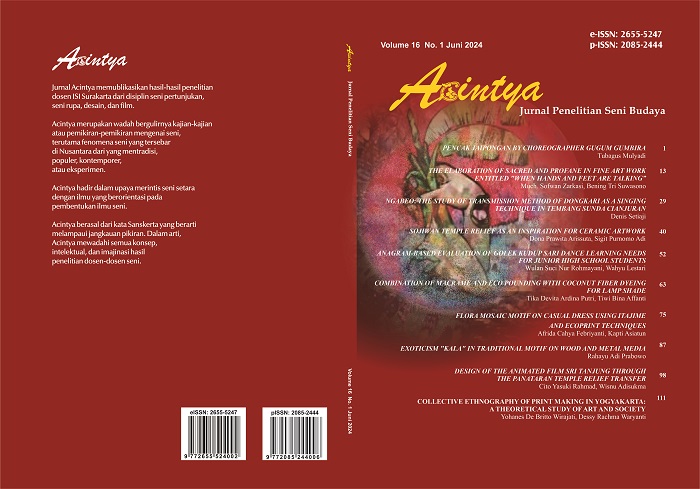EXOTICISM "KALA" IN TRADITIONAL MOTIF ON WOOD AND METAL MEDIA
DOI:
https://doi.org/10.33153/acy.v16i1.6029Keywords:
Kala, aesthetic, metal-woodAbstract
Kala is one of the decorative motifs or ornaments carved on temples in Indonesia. Kala is in the shape of a giant head or face which is an imaginary ornament or imaginary motif which is a form of art from past cultures. The appearance of the kala motif usually does not refer to fragments of the storyline, but rather to a form of display that symbolizes protection and honor. The development of the form of the kala motif has been widely carried out as an act of cultural preservation which has the aim of expanding the meaning of the essence of the existence of the kala motif. Efforts to develop the kala motif in various forms and styles refer to deepening its aesthetic meaning, namely how its existence can be recognized and understood as a form of fine art wealth which is very important to maintain its continuity. This article about kala works is an attempt to develop the aesthetic appearance of kala forms in wood and metal media that have never been presented before. This research uses media and technique exploration methods, namely presenting works in wood and metal media using traditional carving techniques. This method provides a strong understanding of traditional artistic works with presentations that prioritize the main characters of the kala motif, namely firmness, valor, and authority.
Downloads
References
Adhitama, S. (2023). Analisis Keharmonisan Antara Agama Hindu dan Buddha Pada Candi Jawi. Jayapangus Press : Jurnal Penelitian Agama Hindu, 7(3). 330-345. https://doi.org/10.37329/jpah.v7i3.2461
Afrizal., Rahayu Adi Prabowo. (2022). Penerapan Motif Ukir Tradisi Pada Blok Mesin Sepeda Motor. Acyntia : Jurnal Penelitian Seni Budaya, 14(1), 1-16. https://doi.org/10.33153/acy.v14i1.4320
Felix, John. (2012). Pengertian Seni Sebagai Pengantar Kuliah Sejarah Seni Rupa. Humaniora : Languange, People, Art, and Communication Studies, 3(2), 614-621. https://doi.org/10.21512/humaniora.v3i2.3405
Guntur. (2004). Ornamen Sebuah Pengantar. Surakarta : STSI Press.
Gustami, SP. (2007). Butir-Butir Mutiara Estetika Timur, Ide Dasar Penciptaan Seni Kriya Indonesia, Yogyakarta: Prasista.
Kartodirjo, Sartono. (1990). Kebudayaan Pembangunan Dalam Perspektif Sejarah. Yogyakarta : Gajah Mada Press.
Kuswadji. (1981). Mengenal Seni Batik di Yogyakarta. Yogyakarta : Proyek Pengembangan Permuseuman.
Koentjaraningrat. (1990). Pengantar Ilmu Antropologi. Jakarta: PT Rinekacipta.
Koentjaraningrat. (1990). Sejaah Teori Kebudayaan. Jakarta: UI Press.
Nurhidayati, Waode Yeny., Rizky Agung Novariyanto, Nurcholis Sunuyeko. (2023). Candi Wajar dalam Analisis Ruang Publik sebagai Sumber Sejarah Lokal. JIMPS : Jurnal Ilmiah Mahasiswa Pendidikan Sejarah, 8(3), 1072-1083. https://doi.org/10.24815/jimps.v8i3.25007
Poerwodarminto. (1976). Kamus Besar Bahasa Indonesia. Jakarta : balai Pustaka.
Poespoprodjo, W.(2004). Hermeneutika. Bandung : Pustaka Setia.
Prabowo, Rahayu Adi,. Sri Marwati. (2020). Visualisasi Tiga Dimensional Motif Batik Pada Media Kayu. Acyntia : Jurnal Penelitian Seni Budaya, 12(1), 80-87. https://doi.org/10.33153/acy.v12i1.3149
Sunarso, Aryo. (2011). Ornamen Nusantara. Semarang : Effhar Offset.
Soesanto, Sewan. (1980). Seni Kerajinan Batik Indonesia. Yogyakarta : BBKN Departemen Perindustrian RI.
Soeprapto. (2007). Ornamen Ukir Kayu Tradisional Jawa 2. Semarang : Effhar Offset.
Syafi’i, Achmad. (2021). Makna Simbol Relief Sengkalan Candi Sukuh. Acyntia : Jurnal Penelitian Seni Budaya, 13(2), 178-190. https://doi.org/10.33153/acy.v13i2.4050
Toekio, Soegeng. (1991). Anggitan Perlambang Jawa Pada Nekaukir Kayu, Bandung : Thesis, Pascasarjana ITB.
Wicaksono, Agung., Akhamd Nizam. 2017. Viabilitas Ragam Hias Sulur-gelung. Corak : Jurnal Seni Kriya, 5(2), 157-169. https://doi.org/10.24821/corak.v5i2.2385
Sunaryo, Aryo. (2011). Ornamen Nusantara Kajian Khusus tentang Ornamen Indonesia. Semarang: Dahara Prize.
Purnomo, Nurmulia Rekso. (2009). Candi Bangkal: Rekonstruksi Arsitektural, Latar Belakang Keagamaan dan Tinjauan Kronologi. Laporan Skripsi. Jakarta: UI.
Downloads
Published
How to Cite
Issue
Section
License
Copyright (c) 2024 Rahayu Adi Prabowo

This work is licensed under a Creative Commons Attribution 4.0 International License.
Author continues to retain the copyright if the article is published in this journal. The publisher will only need publishing rights




